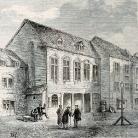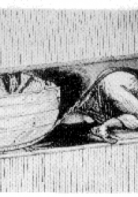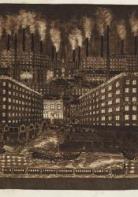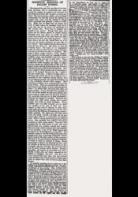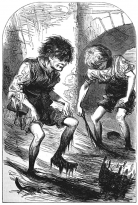Labor in Victorian England
Created by Kassie Monsen on Thu, 12/16/2021 - 13:28
Part of Group:
The Industrial Revolution has left a legacy on the world as know it. It brought many changes and the view of people and society shifted from family to labor. Before the revolution, when you met someone, it was common to ask who their family was, but now, as a result of the Industrial Revolution and rise of labor, it has become common to ask what they do, what they do for labor. This exhibit is focused on the labor of the world of Victorian Britain, the world directly after the Industrial Revolution. Labor in factories, mills, and manufacturing was new and the health and societal issues that came with it were also new. Victorians were unaware and unsure how to deal with the issues that arose from the changes. With time, they did work to fix some of the issues, and this exhibit explores the issues and horrors of labor in Victorian England.
An important thing to recognize and understand when talking about labor in Victorian England is the institutions that were of use at the time. There were workhouses, debtor's prisons, and asylums, to name the ones addressed in the exhibit. These institutions were to help the poor, but quickly lost sight of their purpose. Workhouses and debtor's prisons became places ruled by greedy cruelty. Workhouses divided families and were a way to work, to have a livelihood. Debtor's prisons often split families even more harshly, sending children to work off their parents' debts. Charles Dickens is a famous example. His father was sent to prison and Dickens went to work in a blacking factory. These institutions were an attempt to help with the issue of poverty.
From the world of poverty came a certain of desperation. Women were at a loss for employment and needed an income, so they turned to prostitution. These "fallen women" had no other options. They lived in poverty and faced the scorn of society. It is an argument today whether prostitution is considered labor. For the purposes of showing labor in all aspects of Victorian England, I include the issue of "fallen women." They were laborers in their own right and deserved rights and to live in a situation outside of the extreme poverty and disgrace they regularly faced.
The Victorian Era was riddled with attempts at bettering the lower classes and workers' situations. There were acts of parliament that did take steps to better these situations. There were the earlier acts, ones like the one in 1833, and a few later, in the 40s and 50s. These were the government's attempts and efforts to better labor mostly for women and children. These acts were a good effort to add to the betterment of the laboring classes.
One of the most disturbing parts of labor in Victorian Britain was child labor. The things children did in factories, mines, mills, etc. were terrible and horrific. They were viewed differently than adults. Children could fit in smaller places, so they could do many things adults, especially adult men, could not do. Children were often the ones forced to work when their parents were put into debtor's prisons. Children worked instead of playing. These children were not allowed to actually be children, which makes child labor one of the most horrific parts of labor in Victorian England.
Labor in Victorian England was a result from the Industrial Revolution. It has left a legacy on society. The institutions were well intentioned, but quickly missed their goals. Fallen women are a contradictory form of labor, yet they are laboring and they grew in number at this time. The acts of Parliament were nice attempts to remedy the issues, but were unable to remedy them fully. Child labor is the overarching horror of labor at this time. Labor in Victorian Britain is terrible to us, as it should be.
Timeline
Chronological table
| Date | Event | Created by | Associated Places | |
|---|---|---|---|---|
| 1811 to 1842 |
Marshalsea Debtors PrisonMarshalsea Prison was a prison in South London. In the 19th Century, it was home to many debtors, but it didn’t just imprison debtors. Famously, Charles Dickens’ father, John, was held here. He was imprisoned in 1824, when Dickens was only twelve years old. Dickens was then sent out to make money for his family to repay his father’s debt. This experience impacted much of Dickens’ writing, specifically his novel, Little Dorrit. In Marshalsea Prison, the prisoner’s debts increased with time. The prison was privately owned, like most prisons at the time. Because it was privately owned, the inmates were charged for rent, food, and other necessary items. To add to their debts was the price of having a lawyer or an attorney. Families were often forced to live in the prison together because they had no where else to go. Children were sent to make money to pay off the debts, like Dickens. However, if the prisoners had some money there were restaurants and shops available for them. Even in the prisons there was a separation between the actual poor (those who couldn’t pay for rent) and those who were foolish with their money (those who spent more than they had). I imagine some of those in the debtor’s prison were more privileged than others, like those who had the money to go to the shops and restaurants. This prison had brick barracks where they kept the debtors. It had eight numbered houses that were three stories. In those eight houses, there were fifty-six rooms. These rooms were about ten and a half feet square and eight to nine feet tall. The rooms had boarded floors, a fireplace, and a glazed window. However, the rooms were so small that they only could fit one bed in them. At one point, there were roughly four people per room, four people per bed. The living conditions were described as “cramped and constricted.” To me, this prison is an example of the differences in class. It is shown even among the debtors. Some could pay the rent, some couldn’t. Some could pay for the shops, some couldn’t. The experiences in the debtors’ prison are a shadow in most of Dickens’ writings. It impacted him and was an issue he addressed regularly. Works Cited "Engraving of the Marshalsea Prison, where Dickens's father was imprisoned." British Library. Philpotts, Trey. "The Real Marshalsea." Nineteenth-Century Literature Criticism, edited by Lynn M. Zott, vol. 113, Gale, 2002. Gale Literature Resource Center, link.gale.com/apps/doc/H1420045645/LitRC?u=utahvalley&sid=ebsco&xid=b303b03f. Accessed 22 Sept. 2021. Originally published in The Dickensian, vol. 87, no. 3, Autumn 1991, pp. 133-145. |
Kassie Monsen | ||
| 1824 |
Charles Dickens and the Blacking FactoryWhen Dickens was twelve he was taken from his parents and began working in a blacking factory. His father owed debt and was put in a debtors prison. So, Dickens was sent to work in the factory. It was called Warren's Blacking Factory. It was a warehouse by the Thames that made boot polish. Dickens mostly stuck labels onto the jars of polish. Dickens' experience in the blacking factory played a major role in his novels. There is a common theme of orphans and abandonment in a lot of his novels. Dickens felt abandoned by his parents and as a twelve-year-old boy, being forced to do labor would be a very traumatic experience. Landow, George P. "The Blacking Factory and Dickens's Imaginative World." The Victorian Web, The Victorian Web. https://victorianweb.org/authors/dickens/dickensbio3.html "Warren's Blacking Factory." The Circumlocution Office, The Circumlocution Office. https://www.thecircumlocutionoffice.com/trail/london/warrens-blacking-fa.... |
Kassie Monsen | ||
| circa. 1830 to circa. 1849 |
Liverpool Night AsylumWhile we tend to think of “asylum” as a place for the mentally ill, there were also asylums that ran during the Victorian era that were rather shelters that provided temporary support to other groups. The Liverpool Night Asylum for the Houseless Poor was a building that provided overnight shelter for the homeless population in Liverpool, England. With the industrialization of the country, many people moved into large cities. But the lower class faced many problems with low pay and support, so there were many who lacked stable needs such as food and shelter. Mayhew, Henry. “Asylum for the Houseless Poor.” London Labour and the London Poor, 3rd edition, 1851. Smith, Egerton. “Description of the Liverpool Night Asylum for the Houseless Poor.” British Library, 2nd edition, 1839, https://www.bl.uk/collection-items/description-of-the-liverpool-night-as.... Accessed September 19 2021. Contributed by Jessica Paterson |
Kassie Monsen | ||
| circa. 1830 to circa. 1880 |
Bessy's RealityI was intrigued by Bessy in North and South, and her representation of the detrimental effects of the industrial revolution on the working class. This photo is one of a flax mill, similar to a cotton mill where Bessy would have worked in. As we can see it is extremely crowded both with workers and equipment, which leads to the infamous heath complications within factories. The main illness contracted in cotton anf flax mills was byssinosis, the blockage of the lungs caused by the cotton and flax particles within the air of these poorly ventilated and crowded spaces. Bessy is a prime example of the stresses and unfair conditions put upon child labor in the Industrial Revolution of Britain, even though she was more of a young woman. The need to exchange her suffering for the well-being of her family, and eventually lose her life, was a widespread issue affecting countless British families. Even after the factory act was put into place in 1833 in an attempt to ease the suffering of these children, conditions were far from ideal and would continue to be so until children were able to not be held accountable for their family's finance. Contributed by Grace Rogers |
Kassie Monsen | ||
| Dec 1833 to 1850 |
Child Labor Laws In Victorian Era: The Factory ActsIn nineteenth-century Victorian England and even through the beginning of the twentieth-century, child labor laws were virtually nonexistent and, where they did exist, went largely unenforced by figures in government until the Factory Act of 1833 was passed by English Parliament which offered protections, if a bit scant, to the class of citizen most in need of protection: children. For an upper-class child in Victorian England, a day might be spent tutoring under a nurse between meals in a private estate; however, for the lower class, children were often forced into public jobs that would help supplement their family’s income with some parents treating the children themselves as sources of income. Thus, in the words of a writer with victorianchildren.org, “having more children who worked raised the income of the home,” as children were pawned off to employers who would offer the child board and pay parents as little as fifteen shillings (about $69.82 today) per year for a laborer who would work for upwards of fourteen hours per day and even into the night with scarce breaks for eating or resting (Victorian Children). For many children this life was normal, even expected, and after learning to behave under their new masters, they grew used to the ever-growing threat of death and disease hanging over them as they worked in factory and mining settings with poor ventilation, unclean conditions, and claustrophobic spaces that threatened to suffocate them at every turn. The Factory Acts of the nineteenth century helped to revolutionize how children were protected from the labor force, and, although provisionary and largely unenforced, they helped lay a groundwork that would outline child liberation in the twentieth century. Child Labor Before 1833 Before the signing of the first Factory Act which helped protect the workers in cotton mills, mines, and industrial factories, legal protections for working children were almost non-existent. Some children started working in factories as young or younger than nine years, and their slight bodies were used to perform labor that even adults were unable to accomplish. Many children worked in mines where they were often strapped to a cart filled with coal and forced to pull it on their hands and knees to the opening of the mine for collection. Because the mines were not properly ventilated, respiratory problems and black lung were common among child workers who performed these tasks for twelve to eighteen hour per day (Victorian Child Labor). Other children worked in city cleaning as street sweepers or chimney sweeps, literally crawling into chimneys to clean them only to be scrubbed perfunctorily with salt water and sent down the next one. Without legal protections and a way to enforce them, children were tasked with the most dangerous jobs that ought to have been reserved only for the most able adults among them. To understand this issue more clearly than I can explain it, read the following excerpt from a transcript of an interview with a young woman who had spent most of her life as a laborer: Elizabeth Bently, called in; and Examined. What age are you? – Twenty-three. What time did you begin work at a factory? – When I was six years old. […] What kind of mill is it? – Flax mill. What was your business in that mill? – I was a little doffer What were your hours of labour in that mill? – From five in the morning till nine at night when they were thronged. […] What time was allowed for your meals? – Forty minutes at noon. […] Suppose you flagged a little, or were too late, what would they do? – Stap us. Are they in the habit of strapping those who are last in doffing? – Yes. Constantly? – Yes. Girls as well as boys? – Yes Have you ever been strapped? – Yes. Severely? – Yes. (Scott)
That excerpt was taken from an interview given before the Sadler Committee in 1831 who worked to give a voice to those who were victimized by the institution of child labor.
The Factory Acts Although poorly executed in the beginning, the laws passed by British Parliament were among the first in the world to provide any protections for children in the working class. The Factory Acts, as they would be called, began with an Act called the Cotton Mills Act in 1819. According to the official UK Parliament website, this first Act prohibited children younger than nine from working in cotton mills “with a maximum day of twelve hours for all those under sixteen,” (UK Parliament). The Act was narrow in scope and almost impossible to enforce, but it opened the door for a line of legislation that would follow to provide protections for the weakest in Victorian society. The next Act that would follow came in 1833 that demanded that no child under nine should be employed in any industry as well as limiting work for children under thirteen to no more than nine hours per day. It also provided children with schooling for at least two hours per day and prohibited work at night according to the UK National Archives (National Archives). These advances on their own were revolutionary in the early 1800’s, but what made the biggest difference for those children was the final stipulation of the law which required that four factory inspectors would be appointed to enforce that law and offer heavy fines to those who broke it. Following this Act, several others would be passed in 1844, 1850, and 1884 that would improve working conditions and further restrict working hours to only week-days and part of Saturday. Those laws then remained largely unchanged for the rest of the Victorian Era until the end of WWI. Although the new laws were not perfect and would have to evolve further, the Victorian Era ended with rights granted to workers that could not have been imagined by those soot covered children at its beginning.
Works Cited Moore, Amanda. Factory Act 1850. 2011. Web site. November 2021. Nye, Eric W. Pounds Sterling to Dollars: Historical Coversion of Currency. 2021. Website. November 2021. Scott, Jonathan F. Readings in European History Since 1814. Appleton-Century-Crofts, 1930. eBook. UK Parliament. The Factory Acts. 2021. Web Page. November 2021. victorianchildren.org. Victorian Child Labor and the Conditions They Worked In. 2 March 2013. Website. 1 11 2021. —. Victorian Children in Victorian Times. 11 December 2012. Website. November 2021. Contributed by Kaden Eyre |
Kassie Monsen | ||
| 1835 |
Workhouses in EnglandWorkhouses had been popular and in use in England from the 1600s, but the experienced a revolution in the 1800s. They shifted from being based in rectories and parishes to be a public service. At this time, they also underwent an architectural revolution. There were many men who created plans for workhouses and implemented them. However, there was one who many built their ideas after. Sampson Kempthorne created three basic workhouse shapes. First was the square, pictured here. Then the hexagonal, or “Y” shaped. Lastly, the 200-Pauper plan. Each of these were unique and made room for more and more people to be housed and work there. I am focusing on the square plan. This specific image is a floorplan by Kempthorne in 1835. We see in this floorplan that men, women, and children were all separated from each other. Each had their own section and own places they were to stay. In the Women’s portion, they had a work room, washing room, and laundry. This seems to insinuate the duties women had in the workhouses. The men’s section had two work rooms. They didn’t have much more than that showing they had specific duties that were geared towards whatever work was being done in the workhouse. The children were also separated according to gender, and each had a work room. However, the children also had a place where they went to school. One of the most interesting parts of the workhouses, to me, is this fact that they were separated by gender and age. This implies an interesting contrast between Victorian values. As we’ve discussed, Victorians were obsessed with family and the ideal of the perfect family. It seems very un-Victorian that families would be separated in a place like this. However, the opposing view is the Victorian concern of incest within the family of the poor. There seems to be a conflict here in the workhouse between what Victorian values are and what they mean to the people. The Victorian era is full of contrasts and contradictions. Workhouses show this in an intriguing way. To Victorians, family and God was supreme. Yet, in workhouses we see families split up and separated. The people who could actually help with issues ignore the poor, those who are sentenced to debtor’s prisons and workhouses. This is not a very Christian response to those in need. Overall, workhouses represent to me, the face of Victorian England, below the surface there is more happening. Higginbotham, Peter. "Workhouse Architecture." The Workhouse: The Story of an Institution, 2021. http://www.workhouses.org.uk/buildings/. |
Kassie Monsen | ||
| 4 Jul 1838 |
Huskar Pit DisasterThe Huskar Pit Disaster (also known as the Huskar Colliery Tragedy of 1838) was a terrible event that illustrates the horror children faced working in coal mines. First off, we must understand what coal mines were like. Coal mines were deep pits. They were usually around 300 feet underground. Huskar Pit was used as ventilation for the miners. Whole families often worked in the mines together. Children worked as trappers, hurriers, and thrusters, helping to bring the coal from the rock face to the surface by carts and passageways. While women worked as hurriers, most often. Trappers sat in the dark and waited for the carts to come pulled by the hurriers. Trappers also kept the mine ventilated. Hurriers were strapped to the carts and pushed and pulled them along the passageways until they reached the surface. Thrusters pushed from behind. They kept the cart moving. These were the roles children had within coal mines. The roles of children in coal mines are already horrific, yet on July 4, 1838, 26 children lost their lives. That day was a fairly typical day until the early afternoon. A storm blew in and brought with it rainfall and hail. In this specific coal mine, there was a steam engine which brought the coal and the workers up from the pit. The rain doused the boiler, and the engine was unable to work. The many adult workers moved down to the bottom of the pit where they were to most safe until they could be brought up. The children, both boys and girls, waited for the engine to start again. They heard a thunderclap and were afraid something had exploded in the mine. They had been down in the mines for nine hours already, so they became desperate to save themselves. They decided to take the Huskar Pit ventilation drift out. They climbed it and reached an air door. Outside the door, the rain had caused a small stream to bulge and grow to an abnormal size. The children were unaware of the increasing water. They pushed the door open and were soon washed down the drift. They drowned. 26 children died that day, eleven girls and fifteen boys. When this incident was told to Queen Victoria, she took great interest in it, and it led to the Royal Commission which investigated women and children's labor in coal mines. They have the names of each child that died. I have included them here to help make them a little more real: Catherine Garnett 11 years Hannah Webster 13 years Elizabeth Carr 13 years Ann Moss 9 years Elizabeth Hollings 15 years Ellen Parker 15 years Hannah Taylor 17 years Mary Sellors 10 years Elizabeth Clarkson 11 years Sarah Newton 8 years Sarah Jukes 10 years
George Birkinshaw 10 years Joseph Birkinshaw 7 years Isaac Wright 12 years Abraham Wright 8 years James Clarkson 16 years Francis Hoyland 13 years William Atick 12 years Samuel Horne 10 years Eli Hutchinson 9 years George Garnett 9 years John Simpson 9 years George Lamb 8 years William Wormersley 8 years James Turton 10 years John Gothard 8 years "Huskar Colliery 1838." Mine Accidents and Disasters. Mining Accident Database. 2021. http://mineaccidents.com.au/mine-accident/202/huskar-colliery-1838 "The Huskar Pit Disaster." The Penistone History Archive. 2018. https://penistonearchive.co.uk/huskar-pit-disaster/ |
Kassie Monsen | ||
| 1842 |
1842 Mines ActThis act was instigated by a report from a Royal Commission on women and children in coal mines. The report came back and caused widespread public dismay and horror. It was discovered that coal mine owners had a great lack of concern for their workers. Frequently, children aged 8 were found working underground in the mines, but there were some even younger. The report also had graphic images of women and children working in the mines. It was passed in 1842 very quickly and hastily by Parliament. The act prohibited all underground work for women and girls and boys under the age of 10. This act was supported greatly by Anthony Ashley-Cooper, the 7th earl of Shaftesbury. "Coal Mines." UK Parliament, UK Parliament. https://www.parliament.uk/about/living-heritage/transformingsociety/livi... |
Kassie Monsen | ||
| 1843 |
Drawings by Ernest JonesPerhaps one of the most recurring themes and topics that is ever present in our texts and in the Victorian era in general is the topic of labor. The Industrial Revolution was important but it had its darker sides and consequences. One of these darker sides were the conditions of the people and children forced to work. Ernest Jones was a strong leader, poet, and writer who was very concerned about the conditions of the working class. Jones illustrated these two depictions of ‘The English Town’ and ‘The Grecian City’ around 1843-1853. The contrast emphasizes the horrific conditions of the industrial cities in England during the Victorian Era. The differences in the English city and the Greek city underlines the consequences and conditions that industrialization and urbanization can create. The Greek city’s sky is light, there’s space and nature, and the water is light. On the other hand, the English city’s sky is dark with smog, the water is dark, there’s no nature or space, and it’s filled with warehouses and factories. He depicts the warehouses with names like ‘Bone Grinder & Co.’ and ‘Killmen Bros’ to accentuate the horrible things that happen to the workmen. We see the mistreatment of the working class in North and South with the strike that occurs. The workmen feel like they’ve been taken advantage of and the bosses don’t take them seriously. This mistreatment is also widely covered in The Condition of the Working class in England in 1844. Engels says, “After roaming the streets of the capital a day or two, making headway with difficulty through the human turmoil and the endless lines of vehicles, after visiting the slums of the metropolis, one realises for the first time that these Londoners have been forced to sacrifice the best qualities of their human nature, to bring to pass all the marvels of civilization which crowd their city” (Engels, COVE). With this industrialization, came human turmoil like what Engels said. The conditions of the industrialization were horrific, dirty, and entirely unsafe. The illustration made by Ernest Jones, spotlights the conditions caused by this Industrial Revolution and therefore reveals what England would have looked like during that time period. Contributed by Lexie Persinger |
Kassie Monsen | ||
| 1844 to 1867 |
Later Factory ActsA later act was the Act of 1844. This act was the first to deal with health and safety while working. The machinery was fenced in, so no one could clean the machines while they were going, and children were not allowed to clean the machinery. This act limited the hours worked by children and women. Children ages 9-13 hours shifted to six and a half hours with three hours of school required. Women and children ages 13 and up hours were changed to no more than 12 hours in a day. This act helped provide safety for the workers, both women and children. The Act of 1850 was another act that came. It allowed families to spend more time together because the working hours were set. Women and children were only allowed to work during the hours of six am to six pm during the summer and it changed to seven am to seven pm in the winter. These set hours made it possible for families to gather together and spend time together, even if they worked. The Factory Acts (Extension) Act of 1867 applied all the current legislation to everyone, all factories with 50 or more workers were required to implement and obey all the previous factory acts. This act was considered a landmard measure, however, it was incredibly difficult to enforce because it require constant official inspections. "Later Factory Lesiglation." UK Parliament, UK Parliament. https://www.parliament.uk/about/living-heritage/transformingsociety/livi... "Labor Laws." Foundations of Western Culture: The Industrial Revolution, Foundations of Western Culture. http://foundations.uwgb.org/labor-laws/ |
Kassie Monsen | ||
| 1847 |
Dickens' Urania CottageUrania Cottage was Charles Dickens' attempt to help "fallen women." Fallen women were women who, often through no fault of their own, had had premarital sex. Becoming fallen could have been due to seduction, immorality, or poverty. Once a woman "fell" she was considered unredeemable, no matter the reason. Prostitution was seen as an end to respectable society. Dickens went into this business with realistic expectations. He knew there would be relapses, desertions, and even fits of madness. He knew some would take the help and be grateful while others just could not be helped. Dickens liked being in the nitty-gritty parts of it. He liked being in the day-to-day activities in the home. He was very particular about it being called a home because it pulled away from the idea that it was an institution. Dickens chose the women who he allowed in the home. He would go to prisons and workhouses and find eligible women. He would talk to them and give them his pamphlet, "An Appeal to Fallen Women." In the pamphlet, he told them about the future they were destined to have if they didn't change anything in their lives. Dickens made sure there were daily routines with structure. Dickens also taught them to read and write. He was horrified they didn't know how. |
Kassie Monsen | ||
| Winter 1860 |
Public Meeting About Fallen WomenIn The Liverpool Mercury—a popular newspaper company in the 1800s—there was a particular first-person account that caught the attention of many. For most, it was a small step towards a brighter future; one where women would be more respected. For others, though it was a good act for prostitutes, it still wasn’t enough to aid in the horrible conditions that ‘fallen women’ had to live in. This account described the incredible public meeting that occurred 26 November 1860 where men and women were both invited to and discussed the betterment of prostitutes. As the population grew to exponential numbers in Britain during the Victorian era, the number of prostitutes expanded as well. The church and police were finally starting to look towards the ‘fallen women’ because for most, that was the only way to earn money. Therefore, this called to action a change for the environment these women were forced to live in. The church and police were willing to be considerate and the women were offered lodging and money if they wished to get another job or return to their families (Article in the Liverpool Mercury about a meeting of the 'Fallen Women'). However, they were only offered 26 beds. For an enormous population and a great number of ‘fallen women,’ that would prove to be unhelpful. In the newspaper article, the author states, “The accommodation was found to be very inadequate. If this movement is to be carried on, funds must be forthcoming. Not only a home must be provided, but suitable employment for those who avail themselves of it” (Midnight Meeting of Fallen Women). It was a good first step towards the socio-economic problem yet at the same time, it wasn’t enough to truly change the overall issue. However, people were starting to be more understanding of these ‘fallen women’ because a lot of them were forced to be in that situation. The citizens were compassionate towards them and were willing to help. In that regard, it was a huge step towards a better socio-economic situation during that time. Class, gender, and rank are huge aspects in the themes of the Victorian novels we’ve been reading. How a person earns their money is greatly looked on and determines their character. For ‘fallen women,’ that was seen as something morally horrible and disgusting. However, with this article and account, it reveals the progress that the society was moving towards. There was change in the society and there was change in the novels we studied as well.
“Article in the Liverpool Mercury about a Meeting of the 'Fallen Women'.” British Library, www.bl.uk/collection-items/article-in-the-liverpool-mercury-about-a-meeting-of-the-fallen-women. “Midnight Meeting of Fallen Women.” The Liverpool Mercury, 26 Nov. 1860. Contributed by Lexie Persinger |
Kassie Monsen | ||
| 1871 |
Mudlark IllustrationThe River Thames has played a significant role in British history as communities have built up around it over many centuries, including the city off London. While so many lives have carried on surrounding it, many objects have found their way into the river. This created a peculiar opportunity for London’s poor, and in the 1700s the term “mudlark” arose to describe those who searched along the riverbed during low tides for useful or sellable trinkets. The popularity of this activity would reach its peak in the 1800s, as many Victorians faced poverty and sought any means of income. Works Cited “A brief history of mudlarking.” A Mudlark’s Diary, https://amudlarksdiary.com/2018/08/16/a-brief-history-of-mudlarking/. Accessed 26 Nov. 2021. Gazur, Ben. “The lost treasures of London’s River Thames.” BBC, 29 Jul. 2020, https://www.bbc.com/travel/article/20200729-the-lost-treasures-of-london.... Accessed 26 Nov. 2021. Mudlarks of Victorian London in the River Thames, from "The Headington Magazine" 1871. Contributed by Jessica Paterson |
Kassie Monsen |

